#ainulindale
Text



Made me laugh waaay toooo hard ⤵️





#silm memes#silmarillion#alqualonde#that fukkin fëanor#gandalf#valar#eru illuvatar#glorfindel#ainulindale#maedros chainsaw#maedhros#darkening of Valinor
242 notes
·
View notes
Text
Songs of the Ainur - Personal Work 2023
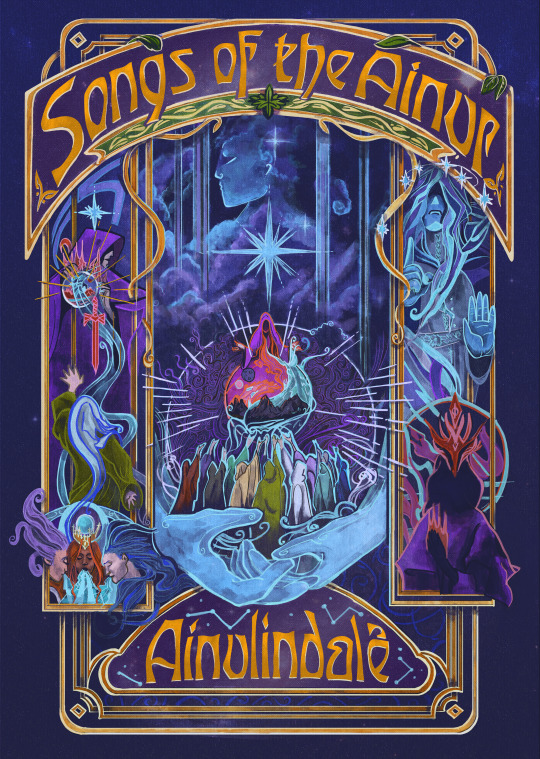

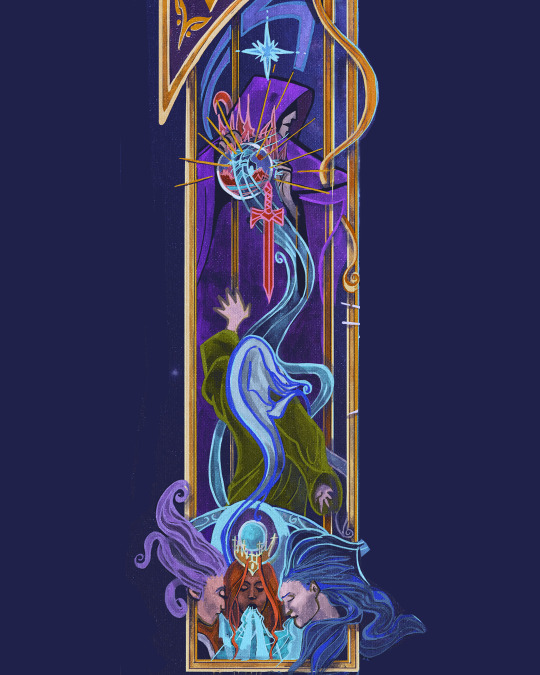

"Songs of the Ainur" - Personal Work 2023
With this painting of the creation of Middle-earth, I tried a slightly different style. I've always wanted to try something like this. It was fun.
#ainulindale#middleearth#lotr#lordoftherings#silmarillion#valar#artnouveau#annajägerhauer#linestyleartwork#noai#humanartist#fantasyartist#annajaegerhauer#illuvatar#elves#god#coverart#art#artistofinstagram#digitalart#fantasy#tolkien#herrderringe#jrrtolkien#illustration#stars#universe#portfolio#morgoth#melkor
265 notes
·
View notes
Text

concept design for an Ainulindalë ballet: Varda! just in time for @ainurweek :P
#clarisse doodles#tolkien ballet#ainulindale#the silmarillion#tolkien#sketch#illustration#varda#elbereth#ainurweek#i hope this is ok even though i'm one day behind with the prompt :)
279 notes
·
View notes
Text
Finally catching up with the Silmarillion Daily and reading the Ainulindalë. I must say that the discord of Melkor takes a whole new level of meaning when there’s bad waiting music coming from my phone as I wait for the doctor to answer my call. This ‘music’ is so utterly nerve grating and discordant I am well immersed in the text I read.
61 notes
·
View notes
Text
The Valar and their action and non-action (especially in the first age and leading up to it) are a complicated subject to say the least, but one part of it, to me at least, is that the Valar so did not sign up for this.
Think about it--Eru shows them a vision of a created world, then they figure out that they have to create it themselves; ok, fine, Manwe and Ulmo have a great time making weather systems, Aule fashioning the mountains, Yavanna her plants, etc. They're having a great time (minus Melkor's interference) literally world-building. This is largely what they are good at and what they want to do.
They did not sign up to deal with political crises, personal/family crises, morality crises, and war, they were probably never intended to have to deal with this in Iluvatar's perfect world, and they are bad at it.
None of this is meant to excuse their, uh...less than stellar decisions, but this post isn't about those, it's about the context of the Valar signing up for Minecraft in Creative mode and not only getting thrown into Survival, but also thrown into adjudicating elf drama, elf marriage/life/death metaphysics, and kinslayings.
Admittedly, they put themselves in a position of authority over the elves, but I still don't think they expected all of that, especially not before they entered Arda, when all they wanted to do was create a beautiful world for the children of Iluvatar.
And then it all went to hell.
#the silmarillion#valaquenta#ainulindale#valar#maiar#ainur#eru iluvatar#elves#calaquendi#softlysilver
399 notes
·
View notes
Text

Real Melkor energy.
#time bandits#david warner#terry gilliam#melkor#morgoth#poor morgoth#ainulindale#tolkien#jrr tolkien#silmarillion#lord of the rings#the hobbit#lotr#lotr rop#lotr trop#fantasy#lotr memes#Tolkien memes
45 notes
·
View notes
Text
I Read The Silmarillion So You Don't Have To, Part One
This is really for the benefit of my mother and sister, who are both diehard Lord of the Rings fans, but who don’t want to read The Silmarillion. My mother remembers picking it up with the expectation that it was another LotR book, and being disappointed that it read more like a history textbook than an actual novel. That’s because it’s not a novel, it’s a mythological epic along the same lines as the Homeric epics or the Epic of Gilgamesh, that tells the history of the first age of Tolkien’s world. It occurred to me that I am exactly the type of person Tolkien wrote The Silmarillion for — a person who knows folklore well enough to appreciate what he was trying to do, and recognize the conventions that he uses. I’m a person who went and applied to Yale’s graduate program in medieval studies (and got in!) just so that I could use the historical, cultural, and literary background of the Middle Ages to inform my own fiction. So, forgive me for saying it, but who’s better equipped to appreciate The Silmarillion than me? And it’s not as long as I thought, with only about 400 pages, which feels really doable after having read Jonathan Strange and Mr. Norrell. So, I’m going to paraphrase the whole of The Silmarillion, for all those who want all the juicy Tolkien lore but don’t want to read it themselves.
Before I get into it, here’s a bit of background, for those less versed in Tolkien lore: The Silmarillion is Tolkien’s magnum opus, which he spent his entire life working on and never properly finished. It could be called a “prequel” to The Lord of the Rings, but that would be misleading. It’s intended to be an original mythology for England, from before recorded history. The Hobbit and The Lord of the Rings are both small episodes from this enormous mythological cycle, and neither is really all that significant in the overall story of Tolkien’s world (which is probably why they actually got finished, and published). The Silmarillion and The Hobbit were originally meant to be completely separate projects, which is why they differ so much stylistically, but Tolkien eventually decided to combine them into the same world. The Lord of the Rings fully integrates the world of The Hobbit and that of The Silmarillion, with copious callbacks to both. (The reason Tolkien wrote it at all is because his publisher wanted a Hobbit sequel and not whatever weird thing The Silmarillion was.) The Silmarillion was not actually published until after Tolkien’s death (because he was never ready to officially declare it finished), and it was edited together by his son Christopher.
Christopher had to do a lot of reworking in order to make the narratives more fluid and consistent with everything Tolkien had written about the world. In that way, The Silmarllion kind of does resemble the ancient epics that it emulates — it’s cobbled together out of its existing material, with many pieces missing or compensated for. Christopher writes,
It became clear to me that to attempt to present, within the covers of a single book, the diversity of the materials — to show The Silmarillion as in truth a continuing and evolving creation extending over more than half a century — would in fact lead only to the confusion and the submerging of what is essential.
Like any mythology, The Silmarillion is fundamentally organic, so what Christopher did is the equivalent of taking a bunch of Ancient Greek primary sources and cobbling them together into something like Ovid’s Metamorphoses: A coherent narrative that arranges all the basic stories from the mythology in chronological order, making it much more comprehensible, but also stripping away all of its inconsistency and nuance. That actually makes it more authentic. The fact that one person was able to produce anything close to the complexity of an entire oral tradition is extraordinary.
I’m not going in blind. I have a general idea of what The Silmarillion is about, and I’m familiar with general Tolkien lore through osmosis (mostly thanks to Quora). I’m interested to see if my initial impressions hold up, how much of what I know about wider Tolkien lore actually comes from this book. I know the Fall of Numenor’s in it. Is Beren and Luthien’s whole romance in it, or is that only in the Unfinished Tales? What about Elendil and the formation of the half-elven line that would eventually end with Aragorn? What about Annatar? I guess I’ll find out.
Ainulindalë: The Music of the Ainur
In which Melkor learns that it’s really disrespectful to deliberately sing the wrong thing during a choral concert.
In the beginning there was God, whom Tolkien calls Eru or Ilúvatar. Ilúvatar creates beings called the Ainur, which are sort of like gods and sort of like angels, and tells them to sing for him. Initially, each Ainu only comprehends the part of Ilúvatar that it represents, but eventually they start to understand each other, and gradually they start to understand Ilúvatar’s big vision of the universe. They start to harmonize, and their singing creates the world. I’m only a few paragraphs in, and it’s already so beautiful I could cry.
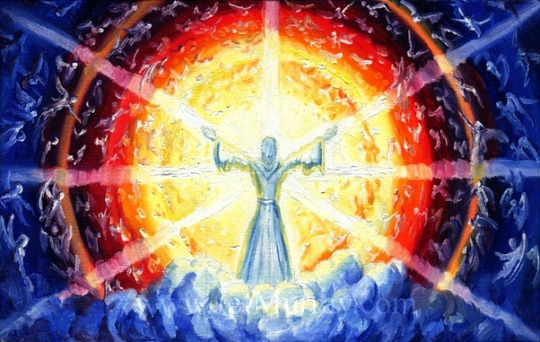
The Music of the Ainur by Jef Murray
The first thing I’m reminded of is the Platonic (and Kabbalistic) idea of emanation — God creates higher beings that are manifestations of his thoughts, and then the higher beings create the physical world, which is a manifestation of their thoughts. Magic in general follows this same pattern of manifesting one’s ideas in physical reality. There’s so much more I could say about that, but this is meant to be a summary and not a theological dissertation. I’m betting it’s not a coincidence, though.
The Ainur are made of Ilúvatar’s ideas, and all of them express Ilúvatar’s ideas through their singing. But — oh no! — one of the Ainur comes up with some ideas of his own, and decides to sing about his own ideas in order to glorify himself. If you hadn’t guessed already, Melkor is this universe’s Satan. Just like Lucifer, Melkor is one of the most powerful and glorious of the Ainur, and he’s a Special-Chosen-One-Magical-Girl because he has a little bit of each of the other Ainur’s powers (i.e. he shares in all of their divine domains). Melkor introduces some discordant notes into his singing, which introduces imperfection to the universe.

Ainulindalë by Paontaur
Most of the Ainur who are in Melkor’s choral section are like, “who the hell is singing off-key?” But some of them like his melody better than Ilúvatar’s, and start singing along with him. This makes matters worse. Ilúvatar simply smiles and starts conducting a new song that’s similar to the first one, but a little different, to accommodate the discordant notes. Melkor and his choir start singing louder in response, and the entire universe becomes the equivalent of a gorgeous violin concerto and a heavy metal riff playing at the same time, each at full volume. To get an idea of what this might sound like, I listened to “The Cloud Atlas Sextet” and the guitar solo from “Seven Nation Army” at the same time, and… it kinda worked, in a weird way, but it definitely sounded like the two songs were competing with each other. Not easy to endure for long, so, a good portion of the Ainur stop singing.
Ilúvatar lifts his other hand, and another song starts up, interweaving with the first. One is slow and sorrowful, the other is loud and abrasive, and together they drown out Melkor’s evil guitar riff. Raising both hands, Ilúvatar ends the music in a single chord that is deeper than the abyss and higher than the sky.
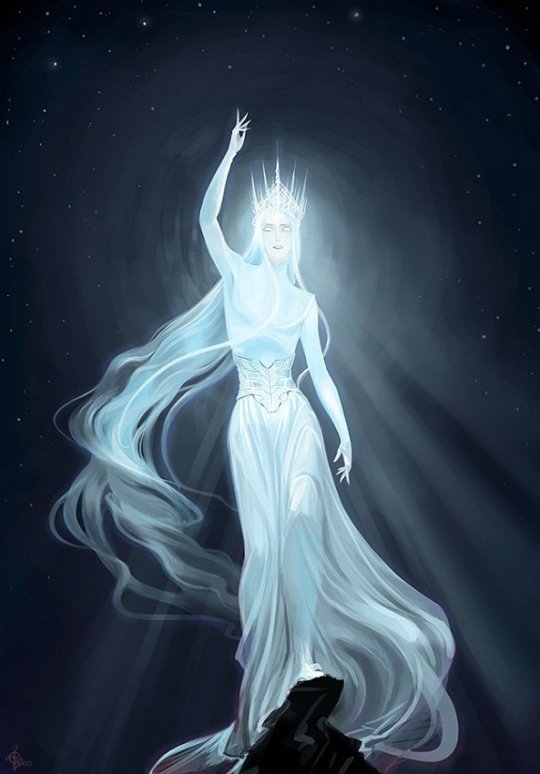
Eru Ilúvatar by Elveo
Ilúvatar addresses the Ainur, telling them that they will now see the things that were created with their music. To Melkor, he says, “If you try to change my music, you’ll find that you’ve actually made my music even better in ways that you can’t even conceive of. Everything you do is going to serve me anyway, so go ahead and try!” So, we get an answer to the Problem of Evil right off the bat. Discord is allowed to exist because, in a roundabout way, it improves the things around it. Every story needs a villain to be interesting, and Melkor is the villain of the story that Ilúvatar is telling.
Melkor feels ashamed, and then resentful. Ilúvatar gives the Ainur the ability to see (when before they were only able to hear), and shows them a vision of the world they made with their singing: Arda. Each recognizes the part of Arda that it personally sang into existence. They see some of the past, present, and future, and they also see things that they hadn’t conceived of. One of these things is a vision of the “Children of Ilúvatar,” the races of Elves and Men. Ilúvatar brought them into existence with the third song (the bombastic-sounding one), and the Ainur didn’t have any part in creating them. Most of the Ainur immediately love the people, and understand more of the mind of Ilúvatar through watching them.
Melkor and his followers, most of which are the most mighty of the Ainur, focus all their attention on Arda (as opposed to anything else in the universe). Melkor convinces himself that his goal is to help the Children of Ilúvatar in by putting the world in order, but yeah… sure, buddy. His real goal is to subdue all the Children of Ilúvatar to his own will instead of that of Ilúvatar.
The rest of the Ainur are very impressed by Arda, and especially by the sea, which contains the distant echo of the Music (which is why all the Children of Ilúvatar feel called by it). The Ainur that sang the water into being is called Ulmo (no, not Elmo), and of all the Ainur, Ilúvatar taught him the most about music. Each of the other Ainur was given a different concept to comprehend and sing into existence. The air and wind was created by Manwë, who is the noblest of the Ainu. The earth was created by Aulë, who’s almost as skilled as Melkor, but his sense of pride is in making beautiful things, instead of in himself.
Ilúvatar shows Ulmo that, although Melkor tried his best to destroy the idea of Water through his singing, all he did was make it even cooler in the manifest world. Melkor created Cold to freeze the water, but all that did was create beautiful snowflakes and whirls of frost, which Ulmo never even conceived of. Melkor created Heat to evaporate the water, but all that did was create the beautiful clouds and the music of rain falling. The clouds have the double benefit of bringing Ulmo closer to his friend Manwë (it probably says something about me that I read “thy friend, whom thou lovest” and immediately thought, SHIIIP!).
So, therefore, everything Melkor does to screw up Ilúvatar’s creation ends up improving it in the long run, and that’s why Ilúvatar allows Melkor to exist.
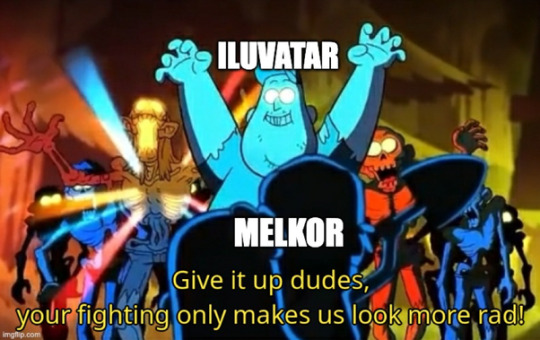
Arda does not actually exist yet, it only exists as an idea that has been described in the singing. So, Ilúvatar formally begins the manifestation of Arda with an epic Let There Be Light moment: “Eä! Let these things Be!” A light appears, and the light is the whole of the universe.
Many of the Ainur choose to remain with Ilúvatar, but a certain number of them descended into the manifest universe, Eä. Making this choice requires them to give up a significant amount of their power and ability for as long as Eä exists. That’s what being alive and in the manifest world does — it shoves you down into a smaller version of yourself and limits the things that you can do. (The Wizards experience this same thing, but on an even smaller scale.) The Ainur that decided to go to Eä are called the Valar, and they function mostly like gods and goddesses.
The Valar are disappointed to discover that the world doesn’t actually exist yet. The singing just conceived of it as an idea, and Ilúvatar kickstarted its manifestation, but now the Valar have to actually build it. So, they begin to painstakingly shape the primordial matter of Eä into Arda, the world as we know it. Manwë, Ulmo, and Aulë do most of the work, but Melkor is there too. Melkor is that guy who doesn’t actually help with the group project, but then takes credit for the whole thing once it’s done. While the other three are building the world, he offers unhelpful suggestions and changes things to make it suit his own vision. When Arda is young and covered in fire, Melkor figuratively plants a little flag on it and names it Melkor-land. Manwë, who was the lead singer of the second melody that Ilúvatar created in response to Melkor, is really pissed off and brings a host of other spirits down to Arda to kick Melkor out. No one gets to claim credit for a group project that everyone else worked on! Melkor goes off into a corner to sulk, and leaves Arda alone… for the time being.
The rest of the Valar give themselves physical forms. Because they’re all excited for the arrival of the Children of Ilúvatar, they base their appearances on the Elves and Men. Their humanlike forms, gender, and so forth are about as inconsequential to them as our clothing is to us, and they don’t always bother to “wear” their humanoid forms. Melkor sees them walking around on Arda in these beautiful forms that emulate the people and the elements of the world itself, and is even more resentful than ever. So, he gives himself his own physical form, and because he’s motivated by spite, his form is dark and scary instead of bright and beautiful. He appears as something like an ice-capped volcano, all fire and ice, striding through the sea.
What follows is the first war between the Valar and Melkor. The Elves don’t know very much about this, so, little of it is recorded. What we know is that Melkor went around and petulantly undid whatever the Valar were trying to do, like your annoying sibling who keeps knocking down your tower of blocks every time you finish building it. Whatever the Valar tried to make, Melkor would destroy. If the Valar made a valley, Melkor inverted it into a mountain range. If they carved out an ocean, Melkor “spilled” it. Everything in the world is therefore corrupted or somehow altered by Melkor, instead of matching the Valar’s original idea for it, but in the end the group project is finished and it comes close enough.
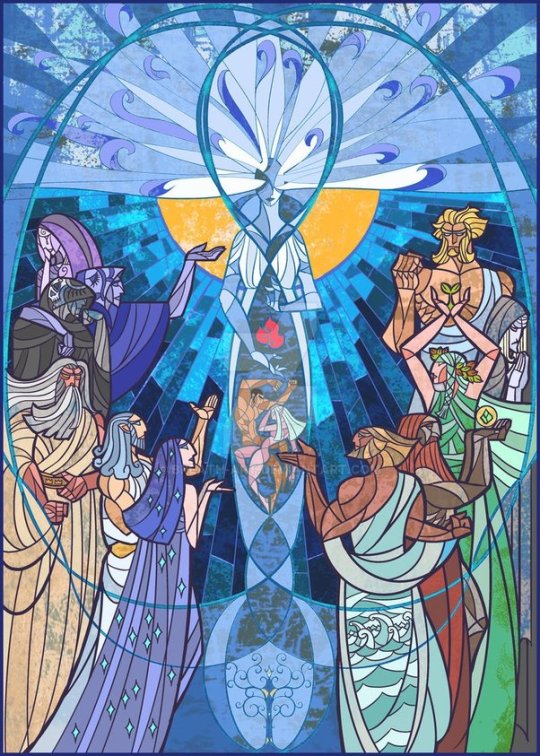
Music of Ainur by breath-art
Valaquenta: Account of the Valar and Maiar according to the lore of the Eldar
In which we’re introduced to the T̶w̶e̶l̶v̶e̶ ̶O̶l̶y̶m̶p̶i̶a̶n̶s̶ Kings and Queens of the Valar, and the Maiar.
This is what every fantasy writer wishes they could do — just exposit on the lore of their gods! I wish I could explain all about my fictional gods and how cool they are at the start of my novels, but I’m not Tolkien. Maybe someday I’ll be famous enough that someone will buy a book like this one that consists of nothing but lore.
Now, imagine that you’re opening the D’Aulaires’ Book of Elven Myths, and reading about the great elven gods (or more specifically, the gods as the Elves know them).
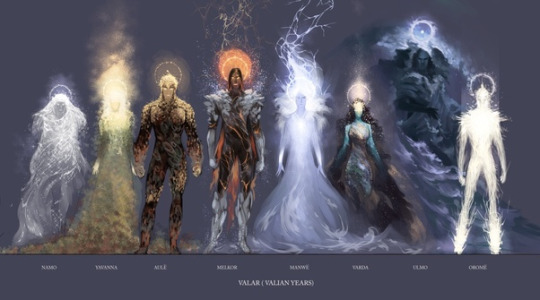
Valar by @phobso
As I usually do with pantheons of gods, allow me to introduce you to the pantheon of Arda! These are the Kings and Queens of the Valar, and there are seven of each:·
Manwë: The god of the sky and wind. He’s the High King of the Gods, just like Zeus. He has the epithet Súlimo, “breather.” Manwë sort of replaced Melkor as the Ainur who best understands Ilúvatar (making him roughly equivalent to the Archangel Michael, if Melkor is Satan).
Varda: The goddess of stars and light, Manwe’s wife. She lives with him in a tower on top of the tallest mountain (Taniquetil), and Being with each other improves their perception, so that they can see and hear everything. Varda hated Melkor before everyone else hated Melkor, and thought he was an asshole even before the Music was sung. The Elves call her Elbereth, and she’s their most important goddess.
Ulmo: The god of water, all water. He spends most of his time in the depths of the ocean, so he doesn’t see the rest of the Valar much and doesn’t bother to take on a human form most of the time. When he does, it is terrifying to see his gigantic form rise out of the waves and hear his voice, which is as deep as the ocean. Despite having disengaged from the other gods, he still loves the Elves and Men. He keeps tabs on them through all the freshwater rivers, lakes, springs, and fountains. Sometimes he wanders on shore in disguise and plays horns made of white shells, which fill whoever hears them with a longing for the sea (like Legolas).
Aulë: The god of rock and metal, precious stones, mountains, smithing, craftsmanship, and terrain. Aulë is the most similar to Melkor in temperament, because both wanted to make things of their own and have others praise them for it. It was mostly Aulë’s job to fix whatever Melkor broke during the creation of Arda, so he hates Melkor as much as anyone else. Melkor, meanwhile, lost his ability to create anything of his own — he can only corrupt or destroy things that others have made, so he especially envies Aulë.
Yavanna: The goddess of nature and agriculture, Aulë’s wife. She usually appears as a woman in a green dress, but sometimes she appears as a Tree of Life who connects the groundwater with the sky. She has the epithet Kementári, “queen of the earth.”
The Fëanturi: The masters of spirits, two brothers who rule over Death and Sleep. They’re called Mandos and Lorién, but these aren’t their actual names—they’re the names of the places they live. Their actual names are Námo and Irmo. (I’m not really sure why they were introduced to us by the names of their domains, but linguistics is weird, and Tolkien fully replicated its weirdness.)
Namó/Mandos: The god of the dead, who lives in the Halls of Mandos, in the far west of Valinor He forgets nothing, knows everything, and knows the fates of everyone. It’s his job to pass judgement upon the beings that live in Arda after they die (or… whatever the elves have instead of death? A sort of purgatory), and he works under Manwë’s authority.
Irmo/Lórien: is the god of dreams, who lives in the gardens of Lórien (now you know where the name “Lothlórien” comes from). The Valar often take breaks in the heavenly world of Lórien whenever Arda becomes too much from them.
Vairë: “The Weaver,” the goddess of history, who records all of time in her webs. She’s Namó’s wife, and lives in Mandos with him.
Estë: The goddess of sleep and healing. Like her husband, she is gentle, refreshing, and not at all like Morpheus.
Nienna: The goddess of sorrow and grief. She mourns incessantly for everything Melkor has ever done, and everything that was hurt or lost as a result. On the slightly brighter side, she’s also the goddess of compassion and hope. She lives even further west than Mandos, and the spirits trapped in Mandos supplicate her for her wisdom. She is Namó and Irmo’s sister.
Tulkas: The god of strength and heroism, who came to Arda specifically to help the other Valar fight Melkor. His epithet is Astaldo, “the valiant.” He has long golden hair and a golden beard, doesn’t need a horse because he can outrun everything, and mostly just punches stuff.
Nessa: The goddess of speed, Tulkas’ wife. She likes running and dancing, and deer follow her everywhere she goes.
Oromë: The god of the hunt and Nessa’s brother. He prefers to stalk around Middle-earth, hunting Melkor’s minions, rather than to live in Valinor with the other Valar. His horse’s name is Nahar. He has the epithet Aldaron or Tauron, “Lord of Forests.” He has a magic hunter’s horn that sounds like the sun rising or like lightning.
Vána: The goddess of youth and flowers, Yavanna’s younger sister and Oromë’s wife.
The influence from the Olympians is obvious, but this little section hints at a lot more depth and complexity in each of these beings (well, the male ones, and about half of the female ones). I’m really interested to see how they develop from here.
In addition to the Valar, there are spirits called the Maiar, which are “of the same order as the Valar but of less degree.” I suppose that means that they’re also Ainur? It’s hard to tell, but regardless, they’re the direct underlings of the Valar and they act as intermediaries, so, we could call them lower-ranking angels. There isn’t any specified number of Maiar, and most of them don’t have names. A handful of them do:
Ilmarë: Varda’s lady-in-waiting.
Eonwë: The herald of Manwë.
Ossë: One of Ulmo’s underlings, the spirit of stormy and choppy seas, who lives near the coasts of the ocean.
Uinen: Ossë’s wife, the spirit of calm seas, who protects marine life. Sailors pray to her to calm the waves, and her hair spreads throughout all the waters. Numenoreans in particular worshipped her. Ossë very nearly joined Melkor, but Uinen prevented this.
Melian: A handmaiden of both Vána and Estë, who lives in Lórien and tends the trees there. She’ll be important in Quenta Silmarillion.
Olorin: Another Maia who lives in Lórien, but he spent a lot of time with Nienna, who taught him compassion and patience. This made him the wisest of the Maiar. He’s not important to this story, but he is important to another story that you already know…
Then of course, there’s Melkor. His name means “who arises in might,” but because he’s evil, he doesn’t deserve to have this name. Instead, the Elves called him Morgoth, which sounds a lot scarier. Because he has some of the powers of all the other Ainur, he can affect all of their creations, but because he’s evil, he can’t do anything with them other than distort and corrupt them. Because he’s arrogant, spiteful, and fixated on ruling the world, this is all he ever does.
Melkor also has Maiar servants among his followers, whom he turned evil; they became fiery demons that the elves call “Valaraukar,” but that we know better as Balrogs. Most of Morgoth’s Maiar don’t have names either, but one of them does. His name is Mairon, which means “admirable,” “excellent,” or “precious.” He was originally one of Aulë’s Maiar, but left his service to join Morgoth, becoming only slightly less evil than Morgoth himself. The Elves decided that he also didn’t deserve his name, and called him Gorthaur the Cruel, or else a name that means (roughly) “abhorred” or “vile” — Sauron.
More to come!
#the silmarillion#silmarillion#tolkien#jrr tolkien#the lord of the rings#lotr#eru iluvatar#melkor#music of the ainur#ainulindale#valaquenta#valar#summary#silm#the silm#silm art#silm fanart
146 notes
·
View notes
Text


The Silmarillion; Ainulindalë.
Well, I tried to make something like a comic version of silm, but from Melkor's side 0W0
Soo...part 1/?
#the silmarillion#melkor#lotr#silmarillion#tolkien universe#tolkien fandom#digital art#silm art#tolkien stuff#webcomic#silm#ainur#ainulindale#arda#eru iluvatar#tolkien#middle earth
867 notes
·
View notes
Text
You know, since the Ainur were the offspring of Eru's thoughts, and Melkor sought to increase the power and glory assigned to him, then it means that his greed came from Eru himself.
Now if Eru harboured thoughts of greed, then it signifies the presence of at least one other being equal in might to Eru, with whom Eru would compete for power and thus become greedy.
What was this other entity doing while Eru was conducting an orchestra? Not lounging on a nebula, surely. If there was a competition, then there must be a standard to judge with. The standard would've been solely creating worlds and not governing them, if Eru simply disappeared after handing the reins of his creation to the Valar.
So there existed at least one other world, perhaps even more shoddily managed, apart from Arda. Could be ours.
In other words, JRRT believed in the multiverse theory.
#tolkien#silmarillion#ainulindale#eru iluvatar#melkor#fyi: i don't care when the multiverse theory came into being#tolkien supported it if i say so
24 notes
·
View notes
Text
My dumb ooc headcanon about Ainur is at some moment when Arda was still unmarred and they just started constructing the world and Melkor hadn’t left them there must be some HUGE debates
The topics of the debates:
Should Arda be symmetrical (I think Mairon was actually in the symmetrical group. Do you think maybe his “eye” symbol was actually inspired by the map of Arda Unmarred?)
Should there be multiple continents instead of one and how about we make the land move from time to time (Suggested by an overenthusiastic Aule, who ironically got his wish granted when Arda was marred)
Should we get multiple seas and maybe a thousand more islands and some exciting whirlpools and beautiful square waves? (Petitioned by multiple Ulmo’s Maiar. Again, wish granted in Arda Marred.)
How many volcanos are too many volcanos and how often are they allowed to explode. (Those Maiar that later turned Balrogs were very active in the debate and were disappointed with the result)
Highest speed limit for winds and should we have tornados and how to plan their regular path.
Ice! We need some place for some nice ice!!
Extreme weather is actually nice and adds diversity to the plate
“Maybe we can have this portion of time very hot and another portion of time very cold and a portion of time in the middle. Create a rotation schedule to make everyone happy.” (Multiple groups were NOT happy about the suggestion for different reasons)
Anaerobic or Aerobic? (Some of Yavanna’s Maiar created photosynthesizing bacterium as an experiment, and accidentally caused the Oxygen Catastrophe, the first and only mass extinction not caused by Melkor.)
Lifespan of animals and plants and how fast and how many they reproduce. (Huge never-ending debate among Yavanna’s Maiar.)
Should we live together with the Children when they come? Do we share everything with them?
How much distance do we keep with the Children?
Do we deserve a place for our own? We are building all this world for them surely we deserve a piece of land for ourselves?
Should we keep a piece of land Children-free to conserve all the plants and beasts (Yavanna and her Maiar zealously supported the idea)
What does “Ruling the World” actually mean (Manwe and Melkor had drastically different interpretation of the concept and there were Valar and Ainur picking sides. Nienna & Namo: We are going to clean up your mess and somehow we suspect it won’t be easy.)
My headcanon is a lot of Maiar left with Melkor due to being unsatisfied with one or more results of these debates.
When they broke the world they genuinely believed they were doing the Right thing Eru always intended. It was the other ones that loved the work created by their hands too much and refused to change.
Melkor revealed his full interpretation of “king of the world” much later, and for many Maiar rebelled and fled with him it was a horrible moment. They got to learn what the sheer power differential between Valar and Maiar really meant.
(My headcanon was most of the Maiar that used to serve Melkor and repented later refused to be directly associated with any Vala ever again.)
#tolkien#the silmarillion#silmarillion#silm#silm headcanon#silmarillion headcanon#ainur#valar#maiar#melkor#morgoth#ainulindale
149 notes
·
View notes
Text
In the midst of this strife, whereat the halls of Ilúvatar shook and a tremor ran out into the silences yet unmoved, Ilúvatar arose a third time, and his face was terrible to behold. Then he raised up both his hands, and in one chord, deeper than the Abyss, higher than the Firmament, piercing as the light of the eye of Ilúvatar, the music ceased.
Alright, now imagine Ainulindalë the Musical (or any other form of stage adaptation with music) and THIS SCENE.
How amazing would that be?
25 notes
·
View notes
Text
Has not a moth ever once desired to touch the sun?
“The great lamp…I MUST see it!”
Methinks perhaps it may overwhelm the poor buggers.
I think, for a moth, doing so would be like looking into the eyes of GOD HIMSELF!!!
#dougie rambles#personal stuff#moths#moth#sun#the sun#insects#wildlife#creatures#beasties#what#no context#idk#lamp#this sounded funnier in my head#shitpost#highbrow shitposting#weapons grade shitpost#ainulindale#the silmarillion#jrr tolkien#middle earth#arien#aule#behold the dawn#dawn#eä#ilmen#first age#arda
23 notes
·
View notes
Text
wanted to make my own designs for the Valar because Tolkien gave us nothing but "blue" and "really really really pretty" and it only seemed fair to do Manwë and Varda first. Finally the world's top malewife and girlboss



91 notes
·
View notes
Text
Extremely cool deep cut about the opening of Rings of Power (more info if you visit the threat)

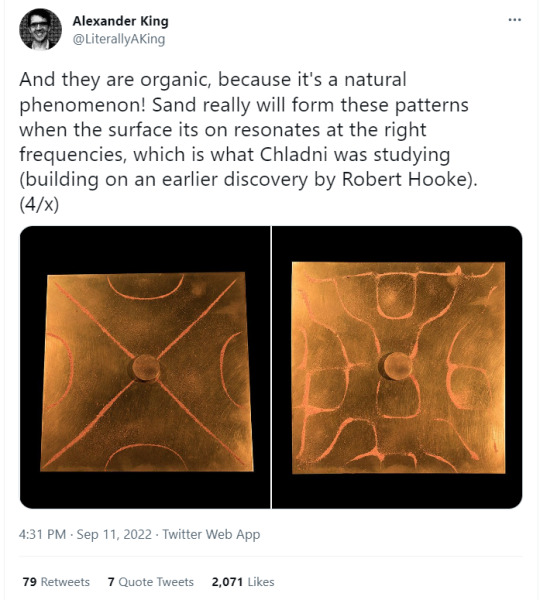
I adore this because the world of Tolkien was created through music, as mentioned in the Silmarillion.
And that was clearly the intention:
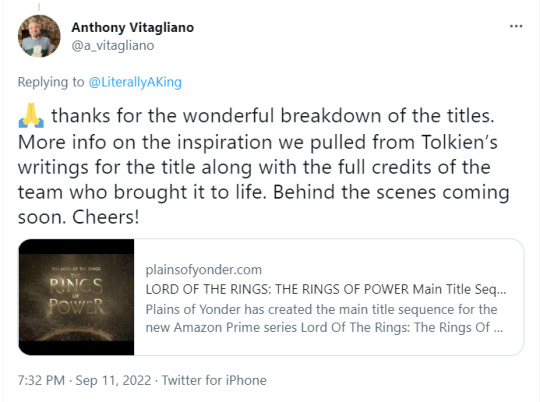
From the plainsofyonder:
We conceived and created the opening title sequence for The Lord Of The Rings: The Rings Of Power. The prequel series is based thousands of years before The Hobbit - a time of Sauron’s ascendency when dragons flew and Proto-Hobbits roamed. We set out to portray a universe both primordial and timeless. Taking inspiration from J.R.R Tolkien’s Ainur, immortal angelic beings that sing such beautiful music that the world is created from their very sound, we conceived of a main title sequence “built from the world of sound.”
Cymatics is a natural phenomenon that makes sound visible to the eye. Vibrations of fine particles on a flat surface display striking symmetrical patterns that reflect audio frequencies. Cymatics are understood by physicists and mathematicians, but to us mere mortals, they are nothing short of magic.
The sequence conjures an ancient and invisible power, struggling to be seen. Symbols form, flow, push, and disappear as quickly as they came. The unknowable realms of sound create fleeting visions of conflict and harmony that move in lockstep with Howard Shores’ opening title score.
It all came together through a digitally connected caravan of creators that ran from Seattle to Chicago to London, Barcelona, Madrid and New Zealand - thanks to our spectacular key collaborators Anthony Vitagliano, Fernando Cózar, Germán Diez, Colin Davis, Nicole López Naguil, Visual Effects/Animation Studio Nexus Studios, and Digital Studio MakMac.
394 notes
·
View notes
Text
Galadriel

Galadriel, the lady of light.
"Galadriel est une elfe Noldor, fille de Finarfin et sœur de Finrod. Elle fait partie des leaders de la rébellion contre les Valar. Mariée avec Celeborn de Doriath, elle reste avec lui en Terre du Milieu à la fin du Premier Âge. Dans les bois de Lothlórien, qu'elle gouverne avec Celeborn, elle est la gardienne de Nenya, l'Anneau de l'Eau."
Création par Intelligence Artificielle.
#lord of the rings#lotr#lotredit#ainur#maiar#valar#silmarillion#tolkien#the rings of power#tolkien fanfiction#le seigneur des anneaux#galadriel#lady of light#noldor#eldar#elfe#finarfin#valardynasty#ainulindale
10 notes
·
View notes
Text

151 notes
·
View notes